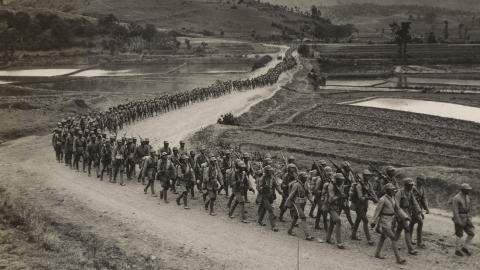
The history of Germany's deadly U-boats
The First World War is often recognised as the first modernised war, and the tactical nature of the conflicts at sea meant a wide range of technology was tried and tested for the first time.
Image: A German U-Boat being launched during the Second World War | Shutterstock.com
While submarines were invented before 1914, it was during the so-called ‘Great War’ that effective submarine warfare was properly underway. Below we're looking more closely at U-Boats, their origins and their importance in the First World War.
Early U-Boats
The word U-Boat is taken from the German ‘Unterseeboot’ and simply means ‘undersea boat’. While any submarine can be described as a U-Boat, it particularly conjures up images of the German fleets in the First World War. However, they were part of the country's naval fleet long before this point.
Germany began testing submarine ships in 1851, but it wasn't until 1903 that the first fully functional submarine, the Forelle, was created. The SM U-1 soon followed this as the first government-commissioned submarine. As new technologies and capabilities emerged, German U-Boats became more sophisticated and world leaders in their class.
The sinking of the Lusitania
Submarines were a core part of the German strategy in the First World War. However, the sinking of the Lusitania changed things. On 7th May 1915, a German submarine U-20 torpedoed the passenger liner, off the coast of Ireland. Approximately 1,200 men, women, and children lost their lives, including over 100 US citizens. The Allied Forces and America, who had not yet joined the war, considered the sinking of the Lusitania an act of indiscriminate warfare.
As the USA was on the verge of joining the war due to the attack, Germany backed down and commanded its U-Boat fleet to spare passenger vessels. However, this order was only temporary.
Unrestricted submarine warfare
On 31st January 1917, Germany renewed its unrestricted submarine warfare in the Atlantic. The torpedo-armed U-Boats were ready and waiting to attack any ship sighted in warzone waters. This quickly came into action when the first German U-Boat arrived in American territory and sank thirteen ships in May 1918. Allied countermeasures were able to blunt the U-Boats' success to some degree, but they had destroyed over ten million tons of cargo by the end of the war.
The Treaty of Versailles required Germany to surrender all of its U-Boats and prohibited them from building any more. However, once Adolf Hitler came into power, U-Boats were again in production and submarine warfare returned when the world was at war again in 1939.
Five facts about German U-Boats
Germany's U-Boats were behind many of their most successful attacks during the First World War, and their advanced and technological design meant opposing forces could not withstand their attacks.
1. The largest U-Boat was the U-151 Class
The typical U-Boat was 214 feet long and held 35 men and twelve torpedoes. They could travel underwater for around two hours at a time. The U-151 class was significantly longer, 315 feet in length, and could carry 700 tons of cargo.
2. The Lusitania hit the seabed in just eighteen minutes
Ships attacked by submarine torpedoes sank extremely quickly, leading to devastatingly high casualty rates. In just eighteen minutes, the Lusitania hit the sea bed, and it's a miracle 761 people managed to survive.
3. 12,850,815 was the total recorded tonnage of shipping sunk by WWI U-Boats
While Germany's U-Boats varied their attacks throughout the First World War, they mainly focused on disrupting shipping and supplies as much as possible. They did this with huge success, with 12,850,815 tons of shipping sunk throughout the war. Their busiest and most productive year was 1917 when the return of unlimited submarine warfare meant they sunk 6,235,878.
4. Germany's U-Boats were far superior to surface craft
U-Boats were quickly seen as the most prolific and effective weapon in the German naval fleet, far surpassing the success of surface craft. It took time for the power of U-Boats to kick in, though. In 1914 surface ships sank 55 ships against only three sunk by U-Boats. However, U-Boats sunk 396 Allied ships and surface craft sank just 23 in 1915.
5. 41 sunken U-Boats were discovered off the coast of England in 2013
In 2013, 41 U-Boats were discovered near England's south and east coasts. The boats were verified as First World War crafts, with most boats believed to have sunk with crews on board. Many of the vessels were still considered missing before this huge discovery.






















